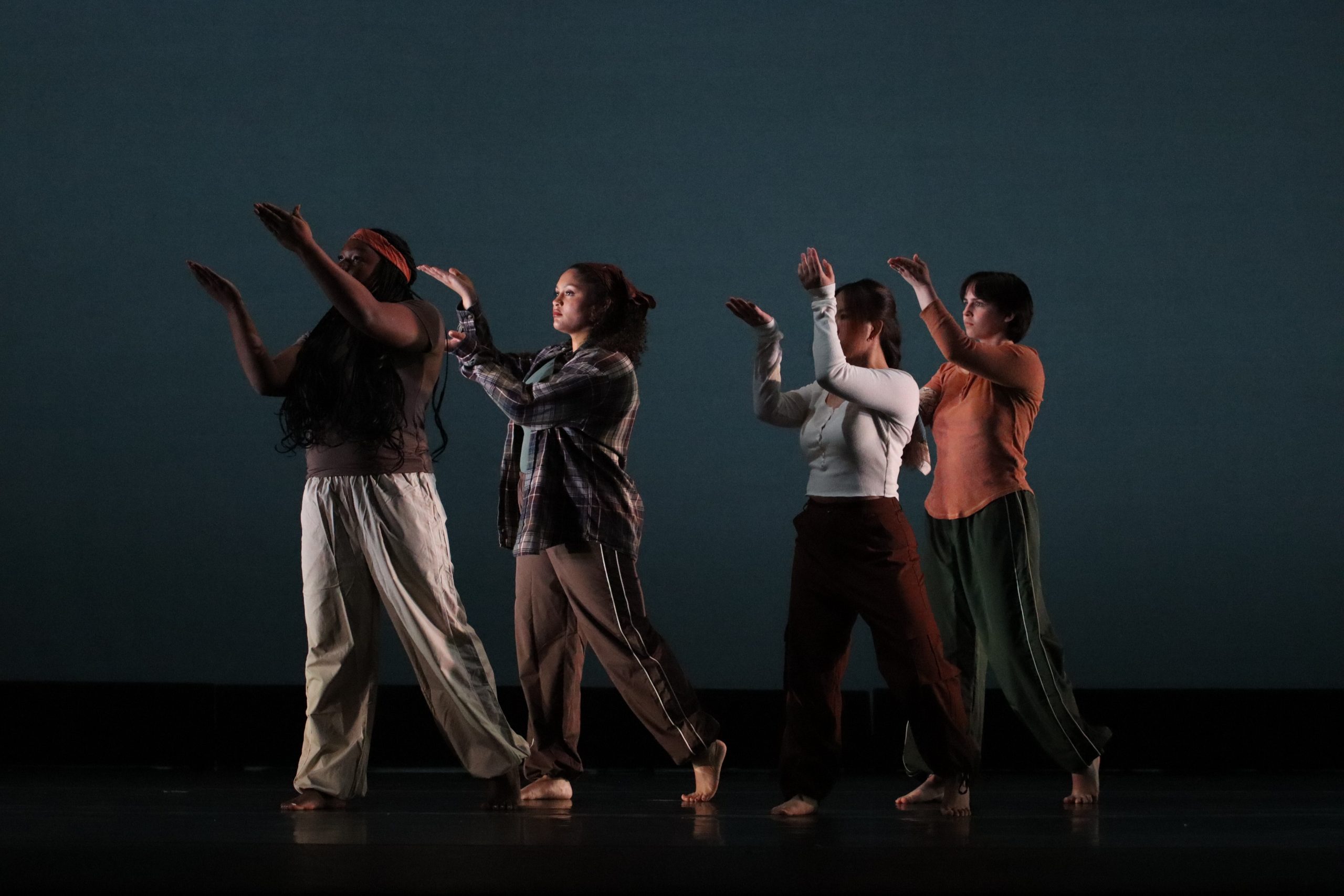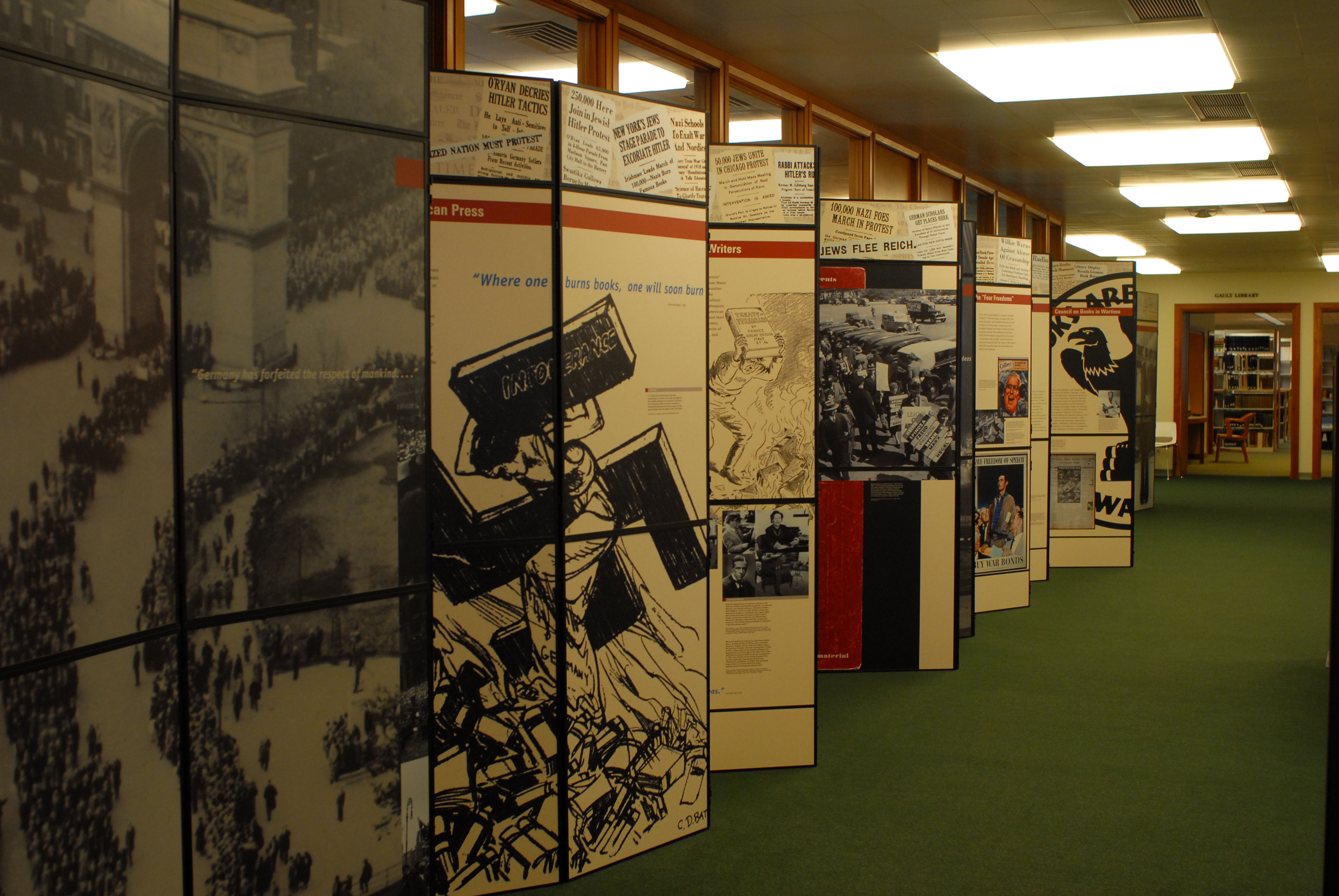
From Thursday through Saturday, April 17-19, The College of Wooster Dance Company held its spring concert in Freedlander Theatre. Before the show, attendees gathered in the lobby, where bulletin boards featured choreographer and dancer biographies and illustrations of some of the costumes worn in the ten pieces. This year, Akron-based dancer Dominic Moore-Dunson served as guest director and choreographer for the concert.
“Grassroots” was the title of the first piece, choreographed by Alexis Neal ’26. “United in Grief” and “Mr. Morale,” both songs by Kendrick Lamar, served as the musical backing for the dance, which was inspired by the concept of protest. The four dancers (Neal, Sayuki Ozaki ’27, Samarah Destin ’27 and Clover Wagner ’28) walked slowly across the stage with swinging arms and stoic faces. The music swelled and Neal, Destin and Wagner lifted a devastated Ozaki into the air as the lyrics sang, “I grieve different.”
“This piece is more about capturing the essence of protest as a social movement and gathering as a community,” Neal said.
“The Hereafter,” choreographed by Lauren Segura ’26, depicted the process of grief and acceptance after untimely death. At the beginning of the piece, Segura turned and leaped lithely to the upbeat tune of Black Sabbath’s “Orchid.” Suddenly, the music stopped and Segura collapsed onto the floor. Dancers Brydon Hollander ’25, Grace Gorkos ’27 and Maura Ellenberger ’25, all clad in beige leotards, drifted out from the wings as the harbingers of a purgatory-like state. The three ghostly dancers moved in slow strides and swift turns to “Planet Caravan,” by Black Sabbath. Initially frightened by her new post-death state, Segura ran offstage in a panic but returned by the end of the piece, wearing the same beige color as her peers and dancing beside them.
Next was “All This and More,” a jazz/ballet piece choreographed by Molly Sugar ’26 that sought to portray dance’s ability to create community and teach individual strength. An instrumental version of “Sweet Child O’ Mine” by Guns n’ Roses played as Sugar, Brooke Johnson ’27, Erica Kahle ’28 and Tali Lansing ’25 practiced pliés at a ballet barre. The group eventually moved away from the barre and into a series of turns, leaps and jazz walks that were interspersed with sharp poses. As the song played its final note, the dancers fell to the floor with exhaustion and giggled until the lights dimmed.
Following that was “Rules of Engagement,” choreographed by Julianna Grimes ’25, which worked to showcase the ways in which people can be controlled without even realizing it. The dance featured Aliza Sosin ’25, Anneke Smeenk ’27, Amanda Crouse ’27 and Grimes. The piece utilized lighting to make the dancers stand out against a red background as they fought with each other. The performance ended with Sosin and Crouse looking at each other as Smeenk and Grimes lay on the floor, exhausted from the battle they were forced to fight, as they walked off stage, seeming to move on to continue the cycle of violence.
Guest director Moore-Dunson choreographed “Flicker,” a commentary on the effects of social media on the perception of the self and the desire to be known. In the accompanying song (“Chase” by Son Lux), woodwinds eked out staccato notes and a tinny drum beat kept the frantic tempo as a female vocalist sang “Will you chase or let me go?” Dancer Ariana Goodwin ’26 stood in the center of the stage while behind her, five other dancers (Sophie Bruce ’26, Rishika Daruwala ’25, Evelyn McCain ’25, Molly Sugar and Justice Swint ’27) crawled forward and began pulling desperately at Goodwin from all sides.
“Sonder,” choreographed by Larissa Cardine ’26, portrayed the complexity of everyday relationships through interactions between three pairs of dancers: representing relationships that are stuck, healthy and toxic. The word “sonder,” Cardine explained, “means that you never know how complex someone’s life can be when you’re just walking past.” At the beginning of the piece, four of the dancers took large, sinking steps and bent low to the ground as Shannon Dunning ’27 and Autumn Smith ’27 posed at center stage. The first song, “Sand” by Nathan Lanier and featuring Karen Whipple, saw Meghan Neville ’26 and Forrest Curry ’25 dancing as a harmonious pair. Meanwhile, Sofia Fazazi ’25 and Andres Gomez Alvarado ’26 displayed tension and discord with sharp movements.
Eleanor Boomhower ’25 choreographed “Ebb and Flow,” a piece inspired by dreams — particularly, the fluidity with which one dream often flows into another. Boomhower, along with Nachi Goto ’25, Laurel Andrews ’25 and Scarlett Svoboda ’28, pranced up and downstage in a dazed state, almost falling into each step. Two of the dancers walked out of sight while the others continued performing fluid motions; the stage formation constantly shifted as dancers left and rejoined the ensemble, as if coming in and out of sleep.
“There Is Still Time,” choreographed by Greenhouse Clark ’25, explored personal transformation through the depiction of insect-like metamorphoses. The dancers crept onstage, each contorting and moving their body in a different, sometimes-jerky-sometimes-fluid fashion akin to the sporadic movements of developing insects. Chive Paradowski ’27 suddenly fell away from the formation, and the rest of the dancers walked in a circle around them as they hunched low to the ground and pulled off their green trench coat to reveal a light blue dress. The rest of the piece saw the other dancers undergo similar transformations, with varying degrees of reluctance and acceptance of the change.
The next piece began with a voice-over recitation of an autism evaluation for Abigail Rahz ’25. “Tools of the Trade,” choreographed by Rahz, blended prop sword fighting and dance to create a fantasy-fueled representation of the autistic experience. A slow, shanty-like tune –– “The Longing (Hurdy Gurdy Version)” by Patty Gurdy –– began and Rahz and Anneke Smeenk ’27 bestowed Wyn Caudle ’27 and Li Winner ’27 with two prop swords. The group engaged in practiced sword combat, with Rahz and Smeenk reprimanding or praising Caudle and Winner throughout each encounter. The performance also featured the songs “Vergers” by Nigel Eaton and “Break Your Crank” by Guilhem Desq. With each song change, the group dynamic shifted, with the other three dancers turning on Rahz at the end and chasing them to the edge of the stage with swords raised.
The night came to a close with “Now I Lay Me Down to Sleep,” choreographed by Josie Fleischel ’26. Featuring “Spellbound” by Siouxsie and the Banshees and “Kashmir” by the London Philharmonic Orchestra, the piece was inspired by the Satanic Panic of the 1980s. Dancers Fleischel, Emma Hetkey ’26, Lilly Hinkley ’25 and Daphne Trillana ’27, wearing white babydoll dresses, ran frantically around the stage as the sound of tolling bells filled the theatre and a thick blanket of fog spread out beneath their feet. The choreography contained a number of allusions to possession; dancers rose from the floor with chests in the air as if pulled upward by supernatural force. Red lights flashed as the group got to their knees and looked into the sky. At the end of the piece, Fleischel, Hetkey and Trillana lay unmoving on the floor and Hinkley strode slowly offstage with one hand on her heart.

